CD Now Available Remastered CD of Music Festival. All 17 original pieces: 51 minutes of vintage computer music. Click to get CD by First Class mail. SOLD OUT! |
|
About the Recording by David Ahl, Founder, Creative Computing THE FESTIVAL The First Philadelphia Computer Music Festival was held August 25, 1978 as part of the Personal Computing ’78 show. It was organized by Dick Moberg of the Philadelphia Area Computer Society. Steve Levine handled technical matters and the recording of the performances. The concert featured more than 30 musical compositions performed on ten computer synthesizers. The LP record made of the concert included 17 musical pieces performed on seven different computer synthesizers, representing programming by 11 people. In addition, a 15-year-old recording of computerized speech by Bell Labs was on the record. THE PERFORMERS The RCA COSMAC numbers were performed in the concert by a team from the RCA David Sarnoff Research Center including Philip Baltzer, Andrew Modla, Jef Winsor and Gooitzen van der Wal. The ALF numbers were programmed by John Ridges and performed by Carl Helmers of Byte Magazine. Desiree was performed by Malcolm Wright of Solid State Music (SSM). Wanhal’s Rondo was performed by Dorothy Siegel of Newtech Computer Systems. Bach’s Toccata & Fugue was performed by Hal Chamberlin of Micro Technology Unlimited. The remaining SSM, Software Technology, Schertz and Bell Labs numbers were performed by David Ahl of Creative Computing. |
RCA COSMAC VIP SYSTEM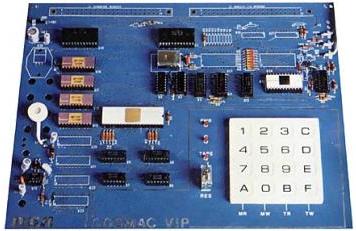 The RCA COSMAC VIP system had 4K of memory with a Super Sound board plugged in. Each Super Sound board yields two separate sound channels. The music is implemented with a program called PIN-8, (Play It Now) written by Joe Weisbecker, who also designed the Super Sound board. Music is encoded from sheet music with note pitch and duration being described with a single 8-bit byte. PIN-8 is structured so that unique measures need only to be encoded once and can be used in any sequence. The amplitude envelope of a note can be controlled to have one of 16 values for each of 16 time segments of a note’s duration.
The RCA COSMAC VIP system had 4K of memory with a Super Sound board plugged in. Each Super Sound board yields two separate sound channels. The music is implemented with a program called PIN-8, (Play It Now) written by Joe Weisbecker, who also designed the Super Sound board. Music is encoded from sheet music with note pitch and duration being described with a single 8-bit byte. PIN-8 is structured so that unique measures need only to be encoded once and can be used in any sequence. The amplitude envelope of a note can be controlled to have one of 16 values for each of 16 time segments of a note’s duration.The program is interrupt-driven and the determining interrupt signal defines the tempo, which is controlled by the potentiometer on the Super Sound card. It is a simple matter to take the interrupt signal from one VIP system to synchronously drive as many other VIPs as desired. The Bach Fugue uses two VIP systems synchronized together. ALF SYSTEM The ALF System uses up to eight music synthesis boards (each one voice) and a control board which connects between the microcomputer and the synthesis boards. Each board can produce one tone (any of 96 pitches) and volume level (256). Each board also gives the programmer extensive control of the waveform and envelope (256 rise rates with times from .004 to 1.3 seconds, 256 fall rates with times from .004 to 7.8 seconds, and 256 sustain levels). Driving the music system was a S-100 bus micro computer with 16K RAM. SOFTWARE TECHNOLOGY SYSTEM The Software Technology Music System is principally a software based system with a small board that plugs into a SOL-20 computer (or other S-100 bus system) with 8K or more memory (see photo and schematic below). Sheet music is programmed in using a high-level language called “Music.” The synthesizer has a bit more than a 4-octave range and can play three voices simultaneously. It provides no control over the amplitude or envelope of the notes although it does provide for staccato notes, various articulation times, durations and tempos. Each board provides output to only one channel, so for stereo, two boards are required. Yankee Doodle Dandy on this record is in monaural. 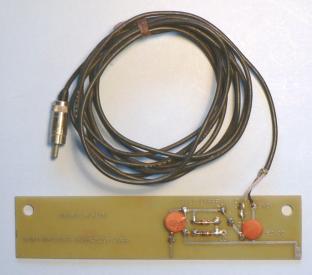 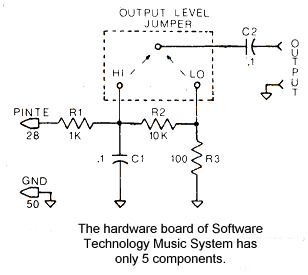 SOLID STATE MUSIC SYSTEM The Solid State Music System had five SB-1 synthesizer cards plugged into an S-100 microcomputer with 32K RAM. Each card provides one channel of music, with control over the envelope and waveform shape, volume, and pitch of the note played over an 8-octave range. Music for the SB-1 is written in MUS-X1, which allows high-level control of the SB-1’s special features and simplified encoding of the music. The MUS-X1 interpreter is also able to play “inverted” music from a normally encoded song. NOTRAN SYSTEM 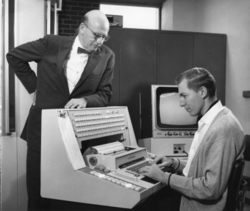 The Toccata and Fugue was realized in 1970 using a music software system called NOTRAN, which is a derivative of the words NOte TRANslation. I developed this as a semester project for a music appreciation course I took while an under graduate student at North Carolina State University. The computer utilized was an Ambilog 200 which is a rather obscure 30-bit word minicomputer (photo at right) equipped with a 14 bit digital-to-analog converter and two IBM style tape drives. Except for the DAC, there was no other sound generation hardware.
The Toccata and Fugue was realized in 1970 using a music software system called NOTRAN, which is a derivative of the words NOte TRANslation. I developed this as a semester project for a music appreciation course I took while an under graduate student at North Carolina State University. The computer utilized was an Ambilog 200 which is a rather obscure 30-bit word minicomputer (photo at right) equipped with a 14 bit digital-to-analog converter and two IBM style tape drives. Except for the DAC, there was no other sound generation hardware.Unlike other systems represented on this record, the NOTRAN, system did not produce sound in real time. Thus, the program “ran” for a much longer time than the duration of the piece. During this time, about 3.5 hours, a series of over 15 million 12-bit numbers was computed. Each number represented the composite sound waveform for a period of about 30 microseconds which means that 32,000 such numbers are needed for each second of sound. As the numbers were computed, they were written onto the tape drive. When the piece was complete, a different “playback” program read the tape at the rate of 8,000 numbers per second and sent them out through the digital-to-analog converter. The resulting audio signal, which was still too slow by a factor of 4, was recorded at 15 inches per second on a laboratory tape recorder. Finally the tape was replayed at 60 inches per second and recorded on a standard audio tape recorder. The primary advantage of such a system is that the sound complexity and detail possible is virtually unlimited since the synthesis program is allowed to run at its own rate. The primary disadvantage, of course, is a substantial waiting period before results are heard. Although many thousands of dollars worth of university owned equipment was used in realizing this piece, any hobbyist system with dual floppy disks (preferably double density) and a digital-to-analog converter could do the same although somewhat more slowly (the Ambilog had hardware multiply/divide). Several features of the system should be apparent while listening to the piece. Since a pipe organ was being simulated, different voicing was used for the great, swell, and pedal keyboard parts. Each part in turn could have several notes sounding simultaneously. In particular, when the decay of one note overlaps the attack of the next , both will be sounding simultaneously for a time, which is a requirement for realism. The voices themselves were an ad-hoc mixture of sawtooth, triangle, rectangle, and sine waves at 1, 2, and 4 times the fundamental pitch. In addition, the attack, decay, and relative loudness of each voice could be specified. Near the middle of the piece the voicing is changed several times. Even the reverberation is computed by the NOTRAN system by simulating a tapped audio delay line in software. —Hal Chamberlin SCHERTZ COMPUTER MUSIC SYSTEM 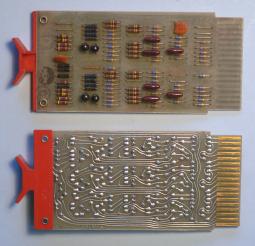 The Schertz System was completely built from kits and surplus parts such as the DEC Flip Chip modules shown at the right. The synthesizer allows for up to 25 parameters to control the note for each of three voices. These parameters include pitch, wave form, attack, sustain, decay, volume, staccato, percussion, tremolo, vibrato, etc. An S-100 bus microcomputer with 20K RAM is used to control three voices in Red Wing. NEWTECH SYSTEM Newtech’s music card for the S-100 bus is essentially a digital-to-analog converter controlled by an output port on the computer. The analog output is fed into amplifiers to be heard. This approach to computer music synthesis is extremely flexible since hypothetically any possible sound can be created. In actual practice the performance of the music circuitry is somewhat limited by the speed of the host computer. Each card can produce up to three voices output to one channel. Newtech's music software consists of a BASIC program, which converts music into binary tables, and a machine-language interpreter to play the music with three voices and different envelopes. The piece on this record uses three cards each playing one voice. BELL LABORATORIES COMPUTER SPEECH To produce synthesized speech, the computer continuously produces nine control signals such as voice pitch, loudness, lip opening and other variables. The program uses 34 phonetic sounds (22 consonant and 12 vowel sounds). This historic recording was made by P. H. Van Lenten in 1962 as part of a series of experiments at Bell Laboratories to understand the nature of speech and hearing. It is even more remarkable considering that each of the nine controls for each phonetic sound was individually keypuhched on a card and processed by a two-part program to produce a magnetic tape. This was then converted by a second program into an audio tape. THE RECORDING One would think that with the music being produced by digital means that the recording could utilize the computer digital outputs, or at least the amplifier outputs. Unfortunately, this was not the case as some of the performances had live accompaniment and those recordings were made with two microphones (for stereo). This fed into a studio-quality 1/4" tape recorder. Also a few of the performers brought their own audio systems, so there is a difference in the quality, levels and balance of the various performances. Lastly, the recording system (borrowed by the Philadelphia Area Computer Society) had a glitch that resulted in the right channel being recorded at a distinctly lower level than the left. In an effort to preserve the music as accurately as possible, virtually no corrections were made between the original tape recording and the 12" stereo record issued by Creative Computing in early 1979. However, in mastering the CD, the right channel was given a bit of a boost to bring the two channels to nearly the same level. More importantly, the levels of the individual pieces were adjusted to compensate for the nearly 50% difference between the loudest and softest pieces in the originals. As this was done digitally, no distortion was introduced and the performances are still pure to the original. Tempting as it was, neither an equalizer nor loudness compensator were used. Unfortunately, as the CD was made from one of the master records (the original tapes had long since disappeared), there are a few pops and clicks, although far fewer than one might expect given that the record was originally pressed in 1978.
|
|||||||||||||||||||||||||||||||||||||||||||||||||||||||||||||||||||||||||||||||||||
|
 |
 |
 |
 |
 |
 |